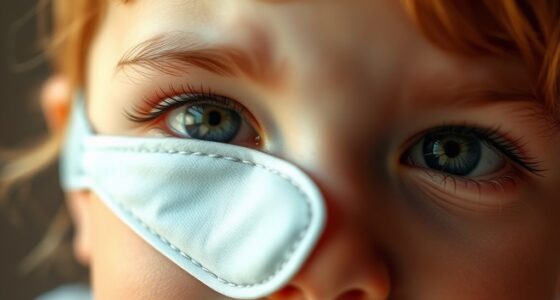Wearing an eye patch goes beyond just pirate vibes; it offers real medical benefits. Patching can help treat amblyopia and improve vision for children with strabismus. After eye surgery, patches provide protection and prevent infections. They’re also useful for aiding recovery from injuries. Plus, eye patches have a trendy place in fashion, making a stylish statement. If you’re curious about the types and additional benefits of eye patches, there’s more to explore.
Key Takeaways
- Eye patches can treat amblyopia by strengthening the weaker eye, promoting better visual development and preventing long-term vision issues.
- They help manage strabismus in children, enhancing eye alignment and overall vision through consistent daily wear.
- Post-surgical eye shields protect against contaminants, reducing infection risk and ensuring proper recovery after eye surgeries like cataract procedures.
- Eye patches assist in recovering from injuries by providing protection and reducing swelling, while also facilitating monitoring of healing progress.
- In fashion, eye patches serve as trendy accessories, symbolizing creativity and resilience, influenced by pop culture and celebrity styles.
Medical Benefits for Amblyopia
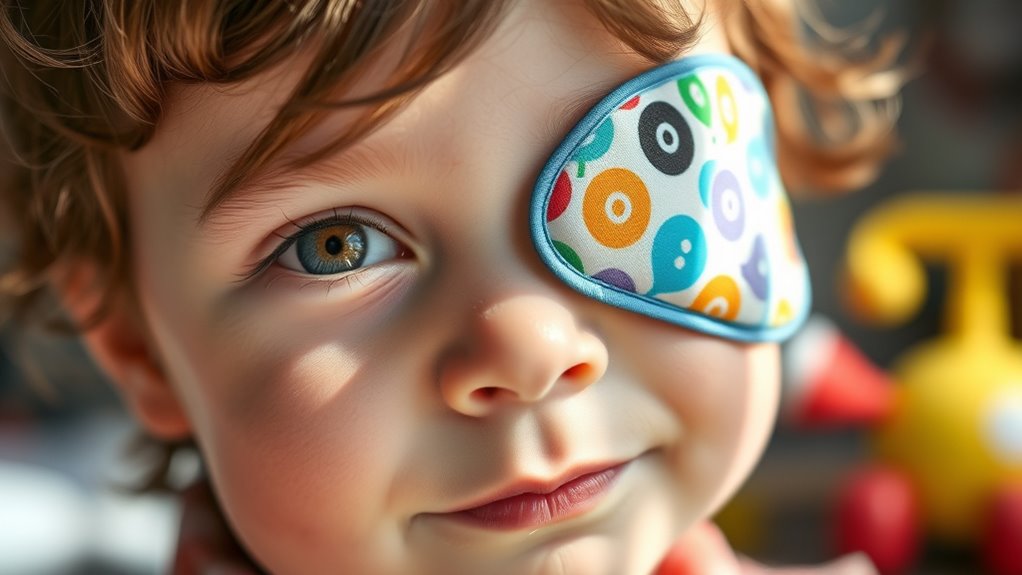
When it comes to treating amblyopia, wearing an eye patch offers significant medical benefits that can greatly improve your child’s vision. By covering the stronger eye, you encourage the brain to rely more on the weaker one, enhancing its development. This method helps create essential connections between the eye and the brain, promoting better visual pathways. Typically, wearing the patch for 2 to 6 hours a day can lead to remarkable improvements, especially if you increase the duration for stubborn cases. Effective patching requires adherence to doctor’s instructions, and early detection and consistent patching are important to preventing long-term vision issues, which could lead to severe problems, including legal blindness.
In short, patching is an effective way to boost your child’s visual health and guarantee a brighter future.
Strabismus Management and Improvement
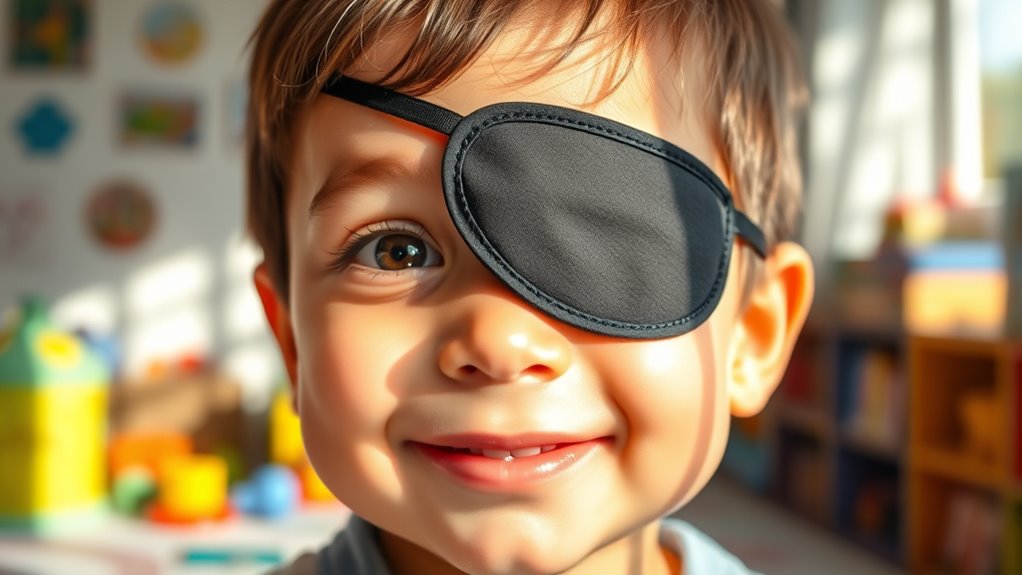
Strabismus management focuses on correcting the misalignment of the eyes to improve overall vision and prevent complications like amblyopia.
If you’re dealing with strabismus, eye patching could be a key component of your treatment plan. By covering the stronger eye, you force your brain to rely on the weaker one, strengthening its function. This technique is most effective for children under 8-9 years old, during essential visual development. Early intervention is crucial for effective outcomes in treating strabismus.
You might need to wear a patch for 2-6 hours daily, and it can take weeks or months to notice improvement. While patching offers a non-invasive, cost-effective option, it’s vital to maintain a consistent schedule and regularly check in with your eye specialist to monitor progress and adjust your treatment.
Post-Surgical Eye Protection
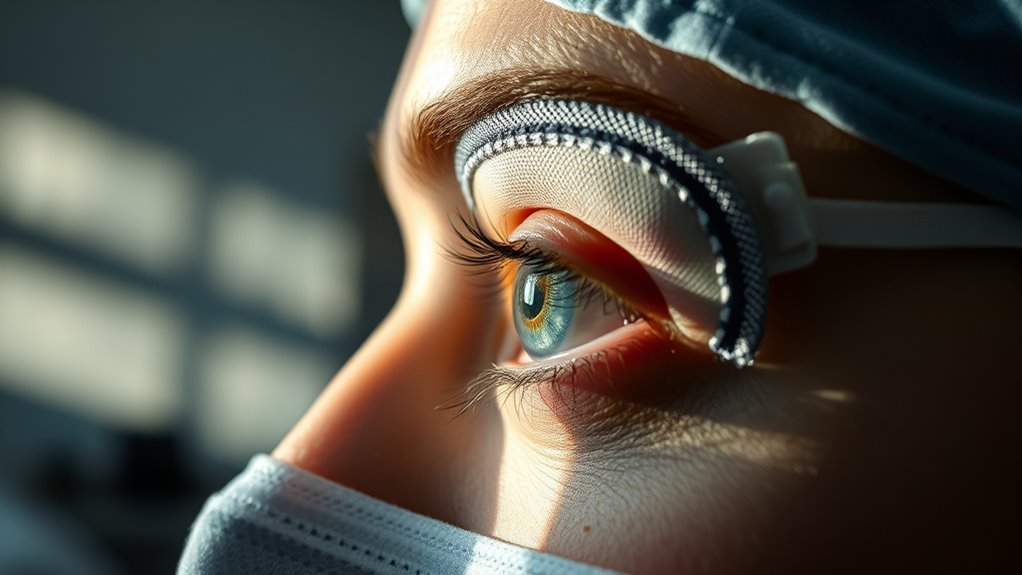
After eye surgery, proper protection is essential for ensuring a smooth recovery.
Wearing an eye shield helps keep your eye safe from contaminants, reducing the risk of infection. You’ll need to wear the shield, especially during sleep, to prevent accidental rubbing or pressure on the eye.
These shields are designed with small holes, allowing some light in while blocking out bright light that could cause discomfort. Typically, you should wear the shield for about a week after cataract surgery. Regular check-ups with your ophthalmologist can further ensure that your recovery is on track and any potential issues are addressed promptly.
Maintaining a clean environment around the shield is vital for preventing infections.
Eye Injury Recovery Assistance

Experiencing an eye injury can be distressing, but knowing how to assist in recovery makes a big difference. First, apply cold therapy immediately to reduce swelling; you can use ice packs or a bag of frozen peas wrapped in a towel. Avoid rubbing the injured eye and don’t bandage it if chemicals are involved—flush it with water instead. Always keep the area clean and monitor for any changes in vision or persistent pain. Elevating your head while resting can help with swelling, and over-the-counter pain medications can provide relief. If you notice worsening symptoms, seek medical attention promptly, especially for vision changes or signs of infection. Staying vigilant during recovery is essential for effective healing, especially since protective eyewear is crucial in preventing future injuries.
Therapeutic Effects on Vision

When addressing various vision conditions, wearing an eye patch can play a significant role in therapeutic interventions.
If you or your child has amblyopia, an eye patch can strengthen the weaker eye by covering the dominant one, enhancing depth perception and visual clarity. Early intervention is vital for the best outcomes, ideally before age seven. Medical professionals should oversee the use of eye patches for best results.
For strabismus, patching helps align vision by blocking one eye, reducing confusion and preventing permanent issues.
If you’re experiencing double vision, using an eye patch can alleviate symptoms like nausea and headaches.
Always consult with an eye doctor for proper diagnosis and treatment, as regular check-ups are essential to monitor your progress and guarantee your eyes are on the path to recovery.
Non-Medical Uses in Fashion and Culture
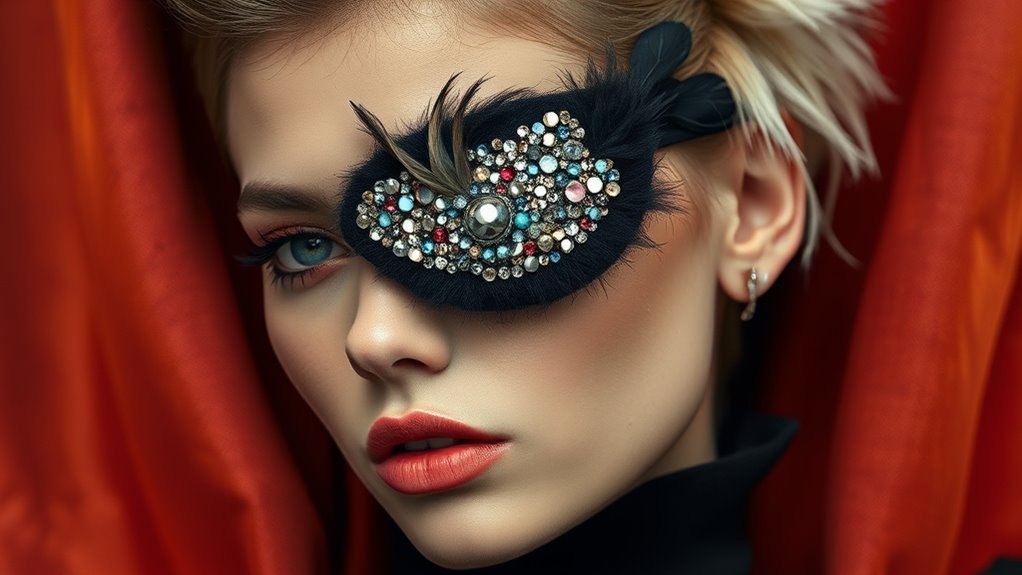
Though often associated with medical uses, eye patches have carved out a unique niche in the domains of fashion and culture.
You’ll notice eye patches popping up in trendy outfits, fueled by pop culture icons and social media platforms like TikTok. They serve as quirky accessories that add flair and drama to your look, often inspiring a sense of community among fellow trendsetters. In particular, the Aye Aye Eye Patch stands out with its luxurious pirate-inspired design, featuring encrusted pearls, diamantes, and sequins.
Celebrities further amplify this trend by showcasing eye patches in their appearances, making them a fashionable statement. Beyond their aesthetic appeal, they symbolize creativity and resilience, drawing on historical associations with piracy and adventure.
Whether for self-expression or style experimentation, eye patches offer a distinctive way to stand out in the fashion landscape.
Types of Eye Patches Available
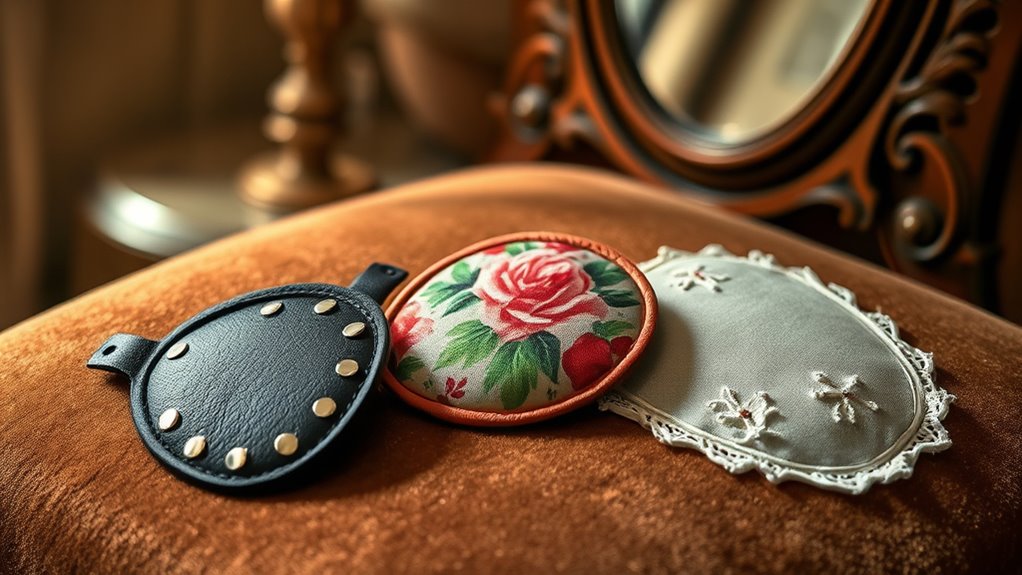
Eye patches come in a variety of types, each designed to meet specific needs and preferences.
Medical eye patches include adhesive options that stick directly to your skin for temporary use, and non-adhesive ones held in place with a strap for longer wear. You might also find gauze pads for post-surgery protection, lens covers that fit over glasses, and bandages to shield your eye from debris.
For children, adhesive patches help with conditions like amblyopia and strabismus. Adults can choose from adhesive or non-adhesive patches based on their needs.
Specialty patches target issues like double vision. Materials vary, with foam, cloth, and hypoallergenic options ensuring comfort while you wear them.
Addressing Social Stigma in Children
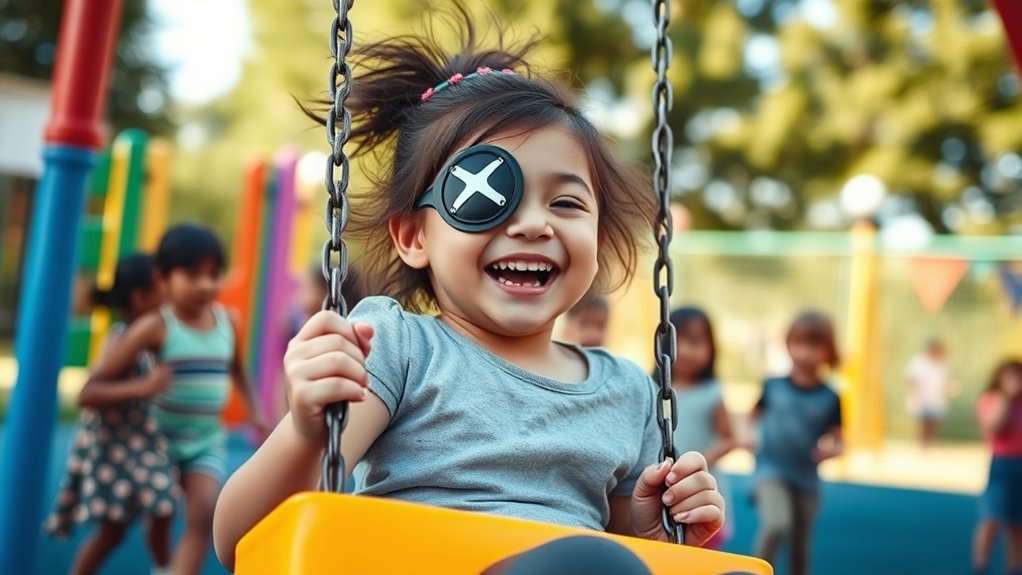
Wearing an eye patch can be a necessary step for children needing vision correction, but it often comes with social challenges. Kids may face teasing or stigma at school, impacting their self-esteem and willingness to wear the patch. Community advice and cultural beliefs can influence how families perceive patching, sometimes leading to skepticism. However, education and awareness can help combat this stigma. Understanding the importance of emotional support during this process can foster acceptance, making it easier for your child to wear the patch proudly. Highlighting the importance of treatment and providing positive role models can build their confidence. Ultimately, addressing these social concerns is essential in ensuring your child adheres to their vision correction plan, particularly since parents’ beliefs can create uncertainty about the benefits of treatment.
Scientific Insights Into Visual Adaptation
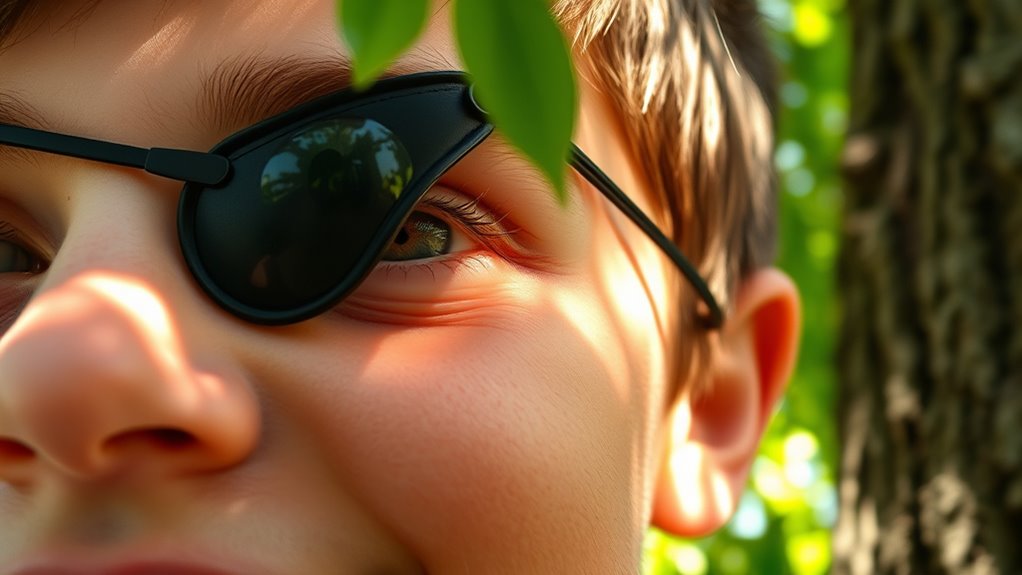
As you explore the fascinating world of visual adaptation, you’ll discover how your eyes adjust to varying light conditions and stimuli.
Your visual system employs fast and slow adaptation mechanisms, quickly responding to changes in just milliseconds, while slower adjustments take seconds or more. This adaptation helps your eyes remain sensitive to different luminance levels, enhancing your visual acuity. Slow adaptation is particularly interesting as it is linked to visual afterimages experienced after the removal of a stimulus.
Each visual pathway—magnocellular, parvocellular, and koniocellular—plays a unique role in how you perceive stimuli, with varying dynamics based on contrast.
Over time, your brain learns to adapt rapidly to new environments, improving your overall visual experience. These adaptations not only sharpen your vision but also help you navigate diverse lighting conditions effectively.
Frequently Asked Questions
Can Adults Benefit From Wearing Eye Patches for Vision Improvement?
Yes, you can benefit from wearing eye patches for vision improvement, especially if you’re dealing with conditions like amblyopia or strabismus.
While patching is more effective in children, adults can still see improvements through various therapies. Patching can help strengthen the weaker eye by forcing it to work harder, but combining it with visual exercises can enhance results.
Always consult with an eye care professional to determine the best approach for your specific situation.
How Long Should One Wear an Eye Patch Daily?
Did you know that about 3% of children are affected by amblyopia, which often requires patching for effective treatment?
If you’re wearing an eye patch for conditions like amblyopia, you should typically wear it for several hours each day, depending on your doctor’s recommendations.
For adults recovering from surgery, patches may be needed for shorter periods.
Always consult your eye care professional to determine the best duration for your specific needs.
Are There Any Side Effects of Wearing an Eye Patch?
Yes, there are side effects of wearing an eye patch. You might experience skin irritation from the adhesive, and your depth perception could decrease, increasing accident risks.
Sometimes, the patched eye may temporarily have reduced vision, though it usually recovers. Additionally, you might’ve reactions to the adhesive, and cosmetic concerns may arise since patches often aren’t covered by insurance for non-medical use.
Always consult a professional for guidance on proper use.
Can Eye Patches Be Worn During Sports or Physical Activities?
Can you wear an eye patch during sports or physical activities? You might think it’s a straightforward yes or no, but the truth is more complex.
While eye patches can offer some protection, they often restrict your vision, making them less than ideal for fast-paced games.
Instead, consider alternatives like goggles or face shields that provide safety without compromising your sight.
Your performance depends on clear vision, so choose wisely!
How Do You Clean and Maintain Reusable Eye Patches?
To clean and maintain reusable eye patches, rinse them with lukewarm water to remove dirt or makeup.
Use a gentle soap or skincare cleanser, avoiding harsh chemicals.
After cleaning, pat-dry with a towel and let them air dry completely before storing.
Keep them in a clean environment, using a storage tin to stay organized.
If you want, refrigerate them for a revitalizing coolness before use, but always verify they’re clean and dry.
Conclusion
Wearing an eye patch isn’t just about channeling your inner pirate; it’s a powerful tool for both medical and personal expression. While it aids in treating amblyopia and protecting eyes post-surgery, it also makes a bold fashion statement. Imagine the contrast between the clinical benefits and the unique style it adds to your look. By embracing the eye patch, you’re not only taking strides towards better vision but also redefining what it means to be fashionable and confident.





